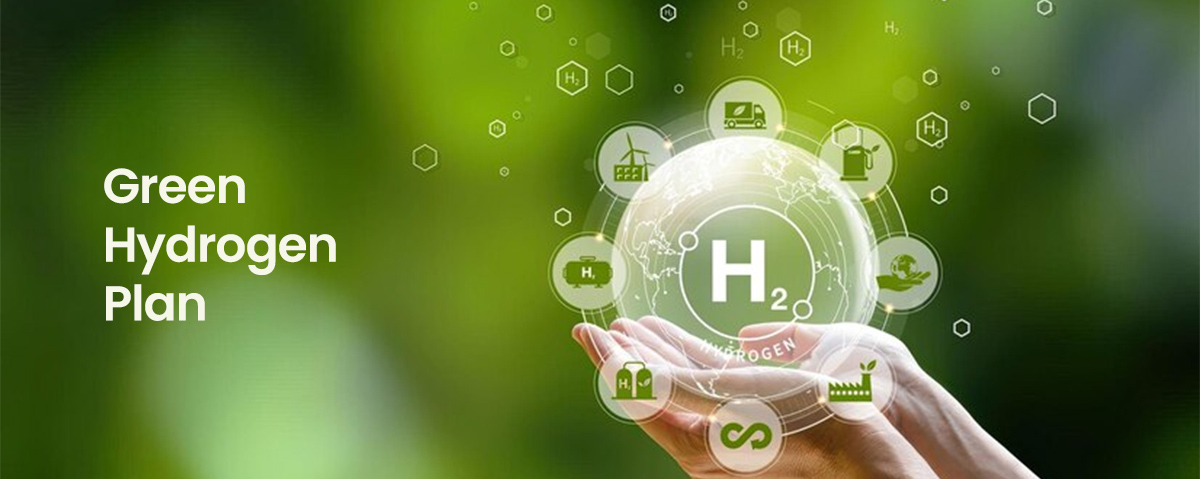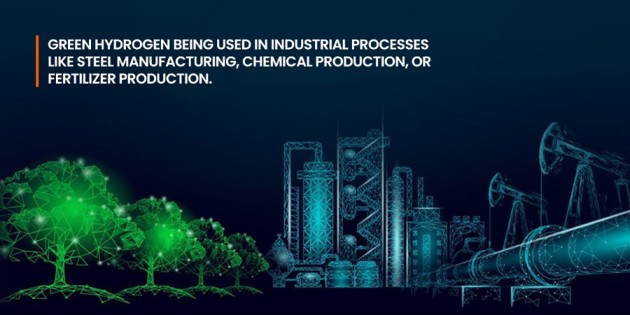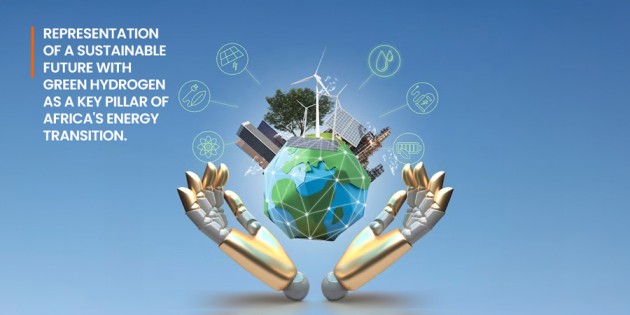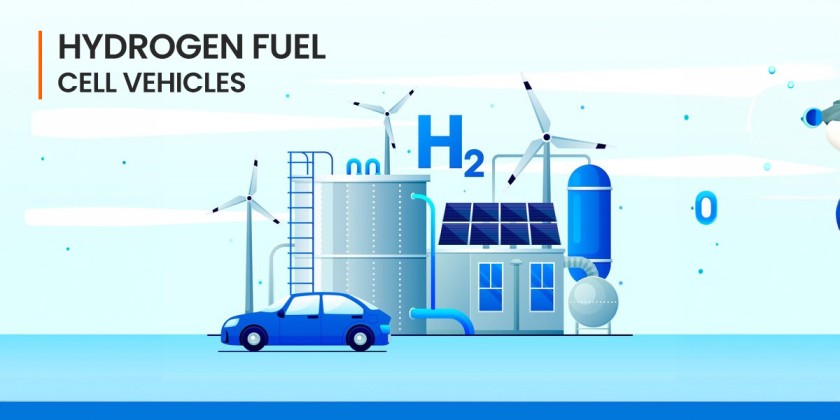Introduction

The global pursuit of sustainable energy solutions has reached a critical juncture, with increasing emphasis placed on technologies capable of reducing carbon emissions and mitigating environmental degradation. At the forefront of this transition stands green hydrogen, a clean energy source derived from renewable resources through the process of electrolysis. As nations strive to meet ambitious climate targets and curb reliance on fossil fuels, the importance of green hydrogen in driving industrial decarbonization and fostering sustainable development has become increasingly evident.
Against this backdrop, the African Green Hydrogen Alliance, comprised of Morocco, Mauritania, Namibia, Egypt, South Africa, and Kenya, marks a significant milestone in the continent's journey towards a greener, more sustainable future. AGHA's establishment signifies a collective commitment to harnessing the potential of green hydrogen technologies to address pressing energy and environmental challenges across Africa. Through collaboration, innovation, and strategic partnerships, AGHA aims to accelerate the adoption and integration of green hydrogen solutions within the region's industrial landscape.
- Morocco is emerging as a key player in the green hydrogen economy, ranking among the top countries expected to produce cost-competitive green hydrogen. With the establishment of the National Hydrogen Commission and a USD 10 billion investment plan, Morocco aims to generate green hydrogen for both domestic use and export. To support its green hydrogen goals, Morocco plans to increase renewable energy's share in power generation to 52% by 2030, 70% by 2040, and 80% by 2050. The country is focusing on expanding solar energy capacity through projects such as the Noor Solar Project, which is expected to invest USD 2.6 billion by 2030
- Other North African countries, such as Algeria and Mauritania, also have significant renewable energy potential. As electricity grids expand across the region, there is a growing focus on using green hydrogen for industry, transportation, and infrastructure development. North Africa's existing pipeline infrastructure and strategic location position it as a potential leader in hydrogen transportation. Early investment in hydrogen blending could pave the way for future regulatory frameworks. Supporting green hydrogen development in North Africa offers mutual benefits for both the region and Europe. With its vast potential and global demand, hydrogen can drive sustainable development in North Africa and provide Europe with new energy import options aligned with emission reduction goals
This whitepaper will explore the significant role of African Green Hydrogen Alliance in facilitating the transition towards green hydrogen within African industries, with a particular focus on sectors such as steel, chemicals, and fertilizers. By delving into the underlying drivers, opportunities, and challenges associated with green hydrogen adoption, this paper aims to provide stakeholders with insights and actionable recommendations to navigate the evolving energy landscape. As Africa embarks on this transformative journey, AGHA emerges as a beacon of hope, guiding the continent toward a more sustainable and prosperous future powered by green hydrogen.
Understanding Green Hydrogen
Green hydrogen, often hailed as the fuel of the future, is produced through a process called electrolysis, where water molecules are split into hydrogen and oxygen using electricity, typically sourced from renewable energy such as wind or solar power. Unlike grey hydrogen, which is derived from fossil fuels and releases carbon emissions during its production, green hydrogen is environmentally friendly, emitting only water vapor when used as fuel. One prominent method of producing green hydrogen involves using electrolyzers, which consist of an anode and a cathode separated by an electrolyte. When an electric current is passed through water, hydrogen ions are attracted to the cathode, where they gain electrons to form hydrogen gas (H2), while oxygen gas (O2) is produced at the anode. The environmental benefits of green hydrogen are significant. It serves as a versatile energy carrier that can be stored and transported, making it a viable solution for decarbonizing various sectors of the economy. For instance, in transportation, green hydrogen can power fuel cell vehicles, offering zero-emission mobility. Moreover, it can be used for energy storage, balancing the intermittency of renewable energy sources like wind and solar power.
In industrial settings, green hydrogen presents opportunities for sectors such as steel production, traditionally reliant on carbon-intensive processes. Companies such as Thyssenkrupp and ArcelorMittal are actively exploring the integration of green hydrogen into their steelmaking processes, aiming to reduce carbon emissions significantly. Moreover, in the chemicals industry, green hydrogen serves as a sustainable feedstock for various processes, offering a pathway to produce ammonia, methanol, and other essential chemicals without carbon emissions. Companies such as BASF and Linde are investing in green hydrogen technologies to drive innovation and sustainability across their operations.
Overall, green hydrogen represents a transformative energy solution with vast potential to revolutionize industries, mitigate greenhouse gas emissions, and accelerate the global transition to a cleaner, more sustainable energy future. As technology advancements continue and economies of scale are realized, the widespread adoption of green hydrogen is poised to play a pivotal role in addressing climate change and advancing energy sustainability on a global scale.
Industrial Demand for Green Hydrogen

Various industrial sectors, including steel, chemicals, and fertilizers, are increasingly recognizing the importance of transitioning to green hydrogen to reduce their carbon footprint and achieve sustainability targets. Traditional methods of production in these sectors often rely heavily on fossil fuels, contributing significantly to greenhouse gas emissions. However, with the emergence of green hydrogen, there is a growing opportunity to transform industrial processes while mitigating environmental impact.
- Steel Industry: Companies such as Thyssenkrupp are exploring innovative approaches to integrate green hydrogen into steel production processes. Thyssenkrupp's "Green Steel" initiative aims to replace coal with hydrogen as a reducing agent in blast furnaces, significantly reducing carbon emissions associated with steelmaking
- ArcelorMittal, a global steel manufacturer, is exploring green hydrogen as a means to reduce carbon emissions in steel production. Their "Steelanol" project aims to utilize green hydrogen in the direct reduction of iron ore, leading to lower emissions and enhanced sustainability
- Chemical Industry: BASF, a leading chemical company, is investing in green hydrogen technologies to decarbonize its production processes. Through initiatives such as the "Clean Hydrogen Economy" project, BASF aims to utilize green hydrogen as a sustainable feedstock for chemical synthesis, reducing reliance on fossil fuels and lowering carbon emissions.
- Linde, a global industrial gas company, is actively involved in developing hydrogen infrastructure and technologies. Linde's "HydroPrime" initiative focuses on leveraging green hydrogen for chemical production, offering environmentally friendly solutions for various industrial applications
- Dow Chemical Company is investing in green hydrogen technologies to drive sustainable chemical production. Their "Project Butterfly" focuses on utilizing green hydrogen as a key raw material for producing various chemicals, contributing to a more sustainable value chain
- Solvay, a multinational chemical company, is actively integrating green hydrogen into its manufacturing processes. Through initiatives such as "Solvay One Planet," the company aims to leverage green hydrogen for hydrogenation reactions, reducing the environmental impact of its chemical production operations
- Fertilizer Industry: Yara International, a prominent fertilizer producer, is exploring the potential of green hydrogen to produce ammonia sustainably. Yara's "Green Ammonia" project aims to replace natural gas with green hydrogen in the Haber-Bosch process, reducing carbon emissions associated with ammonia production.
- EuroChem, a major fertilizer producer, is exploring green hydrogen as a pathway to sustainable ammonia production. Their "Green Nitrogen" initiative aims to transition towards ammonia synthesis powered by green hydrogen, aligning with their commitment to environmental stewardship
- OCI Nitrogen, a leading nitrogen fertilizer manufacturer, is investing in green hydrogen projects to decarbonize its ammonia production. Their "Green Ammonia Initiative" focuses on replacing conventional hydrogen sources with green hydrogen, contributing to carbon-neutral fertilizer production
- CF Industries, another major player in the fertilizer industry, is investing in green hydrogen initiatives to decarbonize its operations. CF Industries' "Green Nitrogen" program seeks to transition towards sustainable ammonia production by integrating green hydrogen into existing manufacturing processes
- Other Industries: Air Liquide, a global supplier of industrial gases, is actively involved in developing green hydrogen infrastructure and technologies. Their "Hydrogen Energy World" initiative encompasses projects aimed at promoting the adoption of green hydrogen across various industrial sectors, including refining, glass manufacturing, and electronics.
- Siemens Energy, a technology company specializing in energy solutions, is collaborating with industrial partners to deploy green hydrogen technologies. Their "Green Hydrogen Solutions" initiative offers integrated solutions for industrial customers seeking to transition towards green hydrogen-based processes, emphasizing sustainability and efficiency
The imperative drives the industrial demand for green hydrogen to reduce carbon emissions, enhance sustainability, and meet evolving regulatory requirements. As companies increasingly prioritize environmental stewardship and sustainability goals, the adoption of green hydrogen is expected to play a pivotal role in reshaping industrial processes and driving the transition towards a low-carbon economy. These companies and their respective initiatives underscore the growing momentum toward green hydrogen adoption across diverse industrial sectors. By leveraging green hydrogen technologies, these companies aim to achieve their sustainability goals, reduce carbon emissions, and contribute to the global transition to a low-carbon economy.
The Role of the African Green Hydrogen Alliance

The African Green Hydrogen Alliance (AGHA) serves as a pivotal platform for facilitating collaboration, driving innovation, and advocating for policies conducive to the widespread adoption of green hydrogen technologies across the continent. In 2021, Namibia revealed an ambitious green hydrogen initiative valued at approximately USD 9.4 billion, with production slated to begin in 2026. The primary aim is to generate 2 gigawatts of renewable electricity for both regional and global markets. During the United Nations Climate Change Conference in Glasgow (COP26), a commitment of USD 8.5 billion was pledged to support South Africa's Just Energy Transition Partnership, aimed at transitioning to a low-emission development path. This funding specifically targets the creation of new economic opportunities, including the development of green hydrogen. In February 2022, South Africa announced plans to endorse a series of green hydrogen projects totaling around USD 17.8 billion over the next decade.
Similarly, Kenya, Morocco, and Nigeria are currently in various stages of formulating plans to integrate green hydrogen into their energy strategies. The global push to advance green hydrogen is evident, and Africa finds itself alongside developed nations at the starting line for the first time. Governments worldwide are promoting both domestic and export-oriented green hydrogen projects, with significant investments earmarked for the coming years.
- One noteworthy instance of AGHA's impact is its partnership with Engie, a global energy company. Together, they are spearheading initiatives to develop and implement green hydrogen projects in various African countries. Engie's expertise in renewable energy and its commitment to sustainability aligns closely with AGHA's objectives, making it a valuable ally in advancing the green hydrogen agenda
- AGHA also plays a crucial role in fostering collaboration among diverse stakeholders, including governments, industry players, research institutions, and international organizations. For instance, through collaborative efforts with the African Union and the United Nations Development Programme (UNDP), AGHA aims to leverage its resources and expertise to accelerate the transition to a green hydrogen economy in Africa
- Furthermore, AGHA actively engages in policy advocacy to create an enabling regulatory environment for green hydrogen development. By advocating for supportive policies and regulatory frameworks at both national and regional levels, AGHA aims to remove barriers and incentivize investment in green hydrogen infrastructure and projects
- Overall, AGHA's multifaceted approach, encompassing partnership-building, knowledge-sharing, and policy advocacy, positions it as a key driving force behind Africa's transition to a sustainable and resilient green hydrogen economy. Through its collaborative efforts and strategic initiatives, AGHA is paving the way for a brighter and cleaner future for the continent
Opportunities for Collaboration
Collaboration opportunities present substantial potential within AGHA and with external stakeholders, fostering a synergistic approach towards green hydrogen adoption.
- Manufacturers can collaborate with renewable energy companies to develop integrated solutions for green hydrogen production. For instance, Siemens Gamesa has partnered with Vestas Wind Systems to explore joint projects for producing green hydrogen from excess wind energy
- Collaboration between manufacturers and research institutions can drive innovation and technological advancements in green hydrogen production processes. Companies such as Toyota Tsusho collaborate with academic institutions to research and develop efficient electrolysis technologies for green hydrogen production
- Strategic partnerships between manufacturers and governments can facilitate policy advocacy and regulatory support for green hydrogen initiatives. For instance, Thyssenkrupp collaborates with the German government to promote the adoption of green hydrogen in industrial processes through financial incentives and regulatory frameworks.
- Manufacturers can collaborate with financial institutions and investors to secure funding for green hydrogen projects. Companies such as Sasol work closely with investment firms to explore funding opportunities for scaling up green hydrogen production infrastructure.
These collaborative efforts are essential for overcoming challenges and accelerating the transition towards sustainable green hydrogen economies.
Overcoming Challenges
Overcoming challenges in green hydrogen implementation necessitates investment in infrastructure, technological advancements, and supportive policies. Collaboration and innovation are essential to address these hurdles, paving the way for sustainable development powered by green hydrogen.
- Infrastructure development poses a significant challenge, requiring substantial investment and coordination. For instance, Air Liquide, a global gas and services company, has undertaken initiatives to develop hydrogen infrastructure, including production, storage, and distribution facilities
- Technological advancements are crucial to improving efficiency and reducing costs associated with green hydrogen production. Companies such as Plug Power, specializing in fuel cell technology, are actively innovating to enhance electrolyzer efficiency and lower production costs
- Skill development and workforce training are essential to ensure the successful implementation and operation of green hydrogen projects. Collaborative efforts between educational institutions and industry players, such as Toyota Motor Corporation's partnership with vocational schools for hydrogen-related training programs, can address this challenge effectively.
Future Outlook:

- The trajectory of green hydrogen suggests a paradigm shift towards sustainable energy systems, offering a beacon of hope for Africa's economic and environmental aspirations. Companies such as Nel Hydrogen Solutions are pioneering advancements in electrolyzer technology, driving down costs and improving efficiency, thus expanding the future viability of green hydrogen. Hyundai Motor Company are investing heavily in green hydrogen infrastructure, including hydrogen fuel cell vehicles and hydrogen production facilities, signaling a bullish outlook for the technology
- The integration of green hydrogen into various sectors, including transportation, industry, and power generation, is expected to catalyze economic growth and create new employment opportunities. Initiatives such as the African Hydrogen Partnership, a collaboration between industry leaders and policymakers, are laying the groundwork for a vibrant hydrogen economy in Africa
- Moreover, as global efforts intensify to combat climate change, green hydrogen stands poised to emerge as a cornerstone of Africa's sustainable development agenda, offering a pathway towards carbon neutrality and energy independence. Projects such as the Kpone Independent Power Plant in Ghana, which aims to utilize green hydrogen for power generation, exemplify the continent's commitment to embracing clean energy solutions for a brighter future
Conclusion
The African Green Hydrogen Alliance (AGHA) offers a promising path towards sustainable industrial development in Africa. By promoting collaboration and innovation, AGHA aims to meet industrial demands while reducing environmental impact through green hydrogen technologies. Despite challenges, such as infrastructure and policy hurdles, AGHA presents opportunities for stakeholders to drive change. With commitment and investment, green hydrogen can revolutionize Africa's industrial landscape, fostering economic growth and environmental stewardship. In summary, AGHA's vision for a greener future requires collective action. By leveraging partnerships and expertise, we can realize the transformative potential of green hydrogen, securing a sustainable tomorrow for Africa and beyond.



